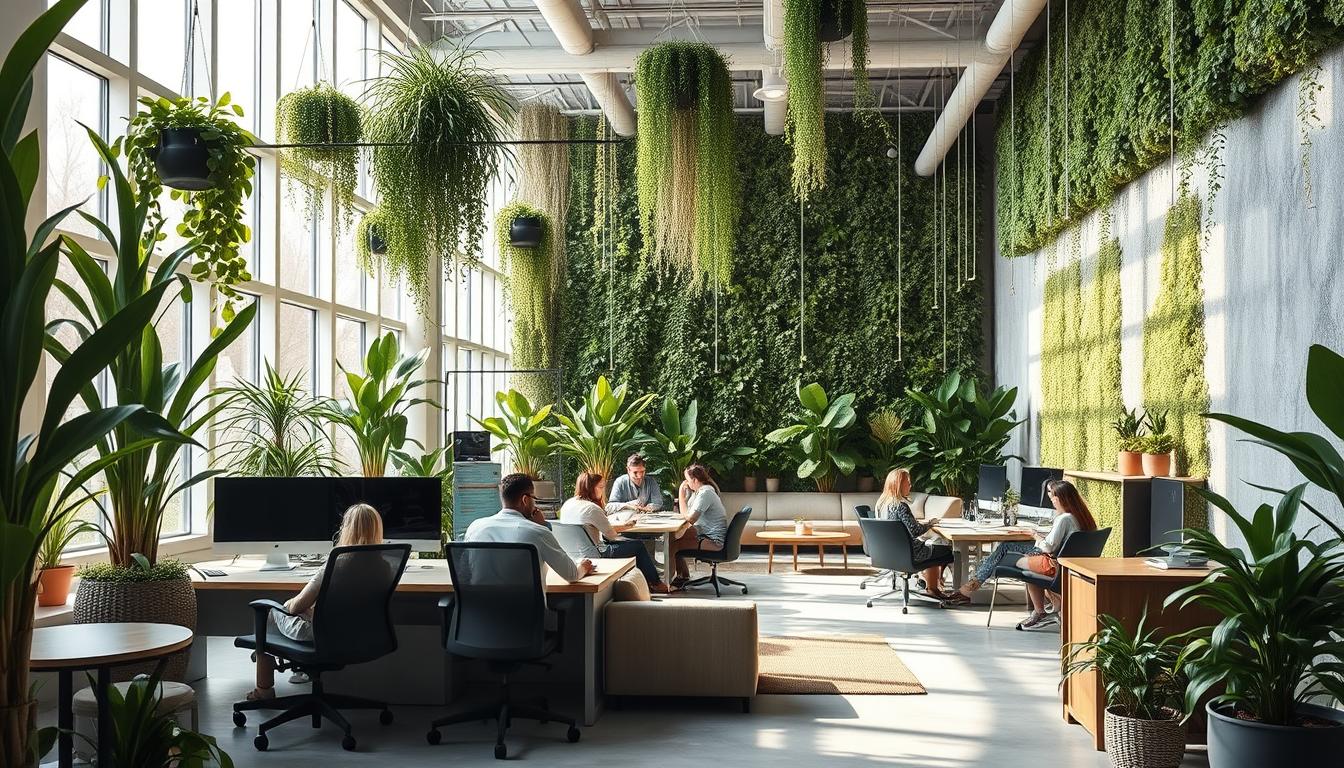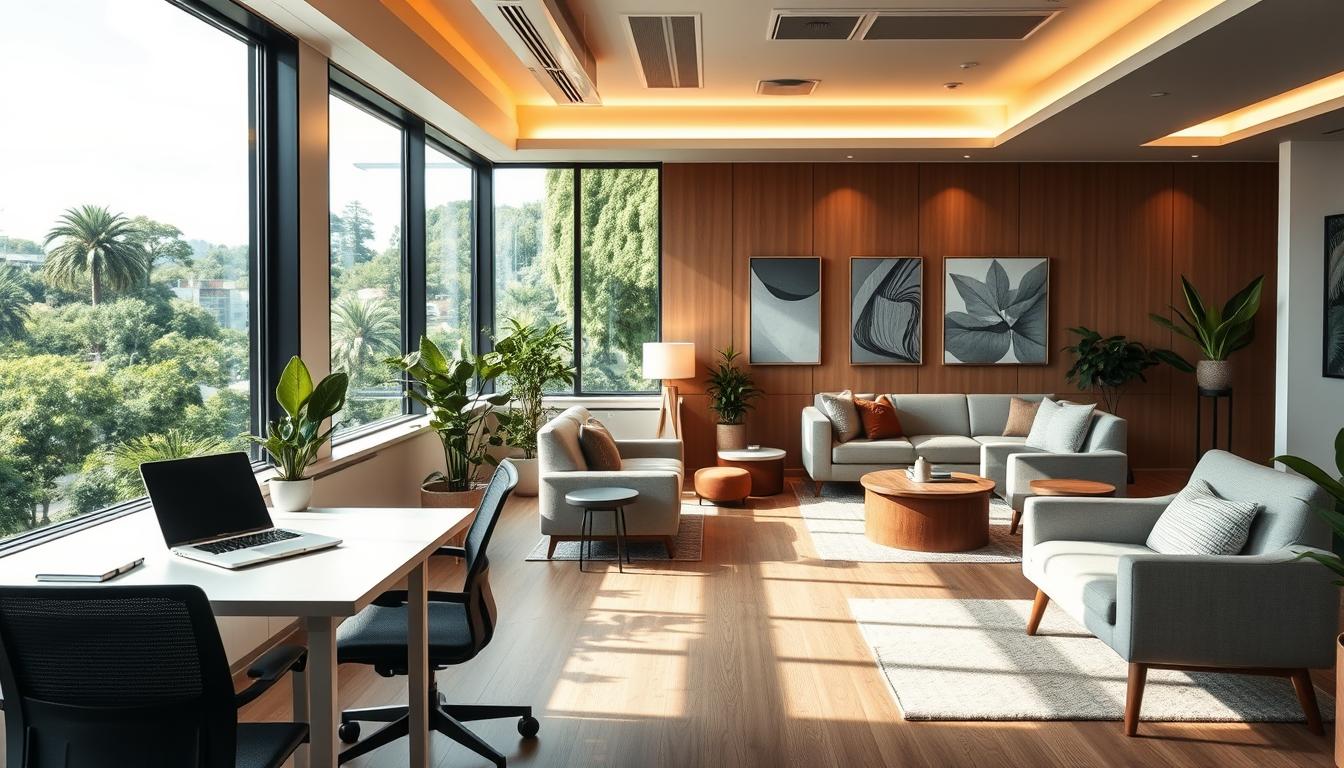Today, it’s all about being kind to our planet. That’s why eco-friendly acoustic solutions are big news in design and architecture. These options use plants, like mycelium, to help manage sound the eco-friendly way. They let architects make places quieter without harming the environment.
This is a win-win. Places become calmer and the earth stays green. Let’s explore how plant-based materials are changing the game. They’re making our spaces quieter and more eco-friendly at the same time.
What Are Eco-Friendly Acoustic Solutions?
Eco-friendly acoustic solutions focus on improving sound management and being kind to the planet. These methods aim to control noise well using materials that are good for the Earth. They are biodegradable, safe, and come from ethical sources. Adding these materials makes spaces better and healthier for everyone.
Defining Eco-Friendly Materials
Eco-friendly materials are key for sustainable sound solutions. They have special qualities like:
- Biodegradability, which lets them break down naturally and lowers trash.
- Non-toxic parts that make the air inside cleaner.
- Getting materials in a way that doesn’t hurt the planet.
Using these materials in green building projects makes construction more responsible. It also keeps the building’s look and feel intact.
Importance of Sustainable Practices in Acoustic Control
Sustainable practices in managing sound are very important. They help the environment and make places better for people. These methods:
- Cut down on energy use and waste during building.
- Make sound systems work better.
- Create healthier places to live and work, boosting productivity and comfort.
By focusing on sustainability, acoustic experts can design sound solutions that are good for the planet and for people.

Understanding the Principles of Sound Management
Effective sound management means knowing all about sound waves and how they behave. These waves have unique ways of interacting with spaces, changing how we feel and use areas. Knowing these interactions helps make better environments for everyone.
Types of Sound Waves and Their Characteristics
There are many kinds of sound waves, such as:
- Direct sounds: These go straight from the source to us, making sounds clear.
- Reflected sounds: These bounce off objects and may cause echoes, making it hard to understand sounds.
- Refracted sounds: These bend when passing through different materials, changing how audio sounds.
It’s key to grasp these types for good sound management. This knowledge allows for improving how sounds are experienced in various places.
How Acoustic Comfort Enhances Space Utilization
Acoustic comfort is huge for using spaces well. Good sound management helps people focus, work together, and talk without annoying noise. It leads to:
- More productivity and focus in offices.
- Better conversations in places like schools and offices.
- A happier and more comfortable environment for everyone.
Making acoustic comfort a priority lets us use spaces better. This creates a place that’s both positive and effective.
The Role of Mycelium in Sound Absorption
Mycelium technology can change how we manage sound. Mycelium is the root of fungi, and it works great for acoustic solutions. Innovative groups like Mogu use it to make products. These help control sound and support sustainable practices too.
The Technology Behind Mycelium
This process uses mycelium’s natural growth to create light, porous materials. When mycelium grows, it combines organic matter into a tough structure. This structure is great at absorbing sound. It makes little waste and is eco-friendly, which is good for the planet.
Unique Properties of Fungal Materials for Acoustic Control
Fungal materials are great at absorbing sound because they are porous. They reduce echo and make places sound better. They also look good, which is a plus for design. By using mycelium, we can manage sound well and care for the environment.
Plant-Based Acoustic Control Solutions
There’s growing interest in sustainable building materials. Now, innovative acoustic solutions are in the spotlight, using plant-based products. These solutions boost comfort and help the planet.
Upcycling textile residues is a key approach. It challenges traditional materials’ norms and is careful with resources.
Innovative Products Made from Plant-Based Materials
Companies are changing the acoustic world with eco-friendly products. Using plants means panels are effective and sustainable.
For instance, Mogu offers panels made from textile waste. This turns possible trash into valuable solutions. It shows you can make beautiful, useful designs and still protect the earth.
Upcycling Textile Residues for Acoustic Panels
Turning textile waste into acoustic panels is key. It lowers waste and supports a circular economy.
These materials keep their sound-absorbing qualities. They’re an excellent choice for modern spaces. Using these, spaces gain better sound and show eco-responsibility.
Benefits of Using Plant-Based Materials for Acoustic Solutions
Using plant-based materials in acoustic solutions has great benefits. It enhances indoor air quality and adds a natural look. This matches modern design trends and makes living spaces healthier.
Enhancing Indoor Air Quality
Plant-based acoustic panels improve the air we breathe indoors. Since they’re made of sustainable materials, they don’t release harmful chemicals like traditional ones do. They help by:
- Lowering levels of volatile organic compounds (VOCs)
- Reducing toxins, making spaces safer for people
- Naturally resisting molds and allergens
Natural Aesthetics of Plant-Based Acoustic Panels
Plant-based acoustic panels look amazing. They add a warm, organic feel to rooms without losing function. They stand out by:
- Offering a variety of textures and colors to match any style
- Blending well with other eco-friendly materials
- Creating a peaceful environment with natural elements
Case Studies of Eco-Friendly Acoustic Installations
The W.W. Lewis Middle School auditorium’s makeover is a prime example of eco-friendly changes enhancing schools. Kinetics Noise Control stepped in after Hurricane Laura. They used advanced acoustic solutions to better the sound clarity and look of the space.
W.W. Lewis Middle School Auditorium Transformation
This project showed how acoustic technology can be used in schools. Eco-friendly materials improved sound control. This let students and teachers talk more easily. The design focused on green practices, making a learning-friendly environment.
Impact on Occupant Well-Being and Productivity
The eco-friendly changes made a big difference in how people felt. Better sound design made the space quieter, reducing distractions. This helped students focus and take part more. This shows how good acoustics can change schools and students’ learning experiences.
Comparative Analysis of Conventional vs. Eco-Friendly Acoustic Solutions
Moving towards eco-friendly acoustic solutions far outweighs the old ways. These green options break the myth that being sustainable is always pricier. They show that you can save money and still get top-notch performance.
Cost-Effectiveness of Eco-Friendly Solutions
Choosing eco-friendly materials for soundproofing can save a lot of money over time. Several reasons make these materials cost-effective:
- Durability and longevity of materials.
- Reduced maintenance costs due to higher resilience.
- Lower lifecycle costs compared to traditional solutions.
An in-depth look at the finances shows that the initial costs are balanced out by these perks. This makes going green a wise choice for projects looking to the future.
Long-Term Sustainability Benefits
Using green solutions for sound doesn’t just help the planet. It also makes indoors better for everyone. The main benefits of sustainable practices include:
- Minimized environmental impact through the use of renewable resources.
- Improved indoor air quality, contributing to occupant health and comfort.
- Alignment with sustainable practices that appeal to environmentally conscious businesses and consumers.
This proves why eco-friendly options are a smart pick in designing for sound. They help create a future that’s healthier and greener for everyone.
Choosing the Right Acoustic Control Products
Picking the right acoustic materials needs careful thought about various things for the best sound solutions. When selecting acoustic control products, it’s key to look at things like how well they absorb sound, if they’re good for the planet, and if they match the look of the space. Knowing these points helps you make smart choices.
Factors to Consider When Selecting Materials
Keep these in mind when choosing acoustic materials:
- Absorption Coefficients: Check how well the materials soak up sound across different pitches.
- Sustainability: Choose products made from materials that are gentle on the environment.
- Aesthetic Compatibility: Make sure the materials fit the style and atmosphere of your space.
Consulting Acoustic Experts for Optimal Solutions
Talking to acoustic experts is vital for getting the best sound solutions. These pros can look into the sound of a room to find out what each project needs. Their knowledge helps in:
- Choosing products that fit the project’s specific needs.
- Picking materials that do well in performance and are eco-friendly.
- Making sure the installation improves comfort and works well.
The Future of Plant-Based Acoustic Control Solutions
The future of green acoustic solutions looks very promising. This is thanks to new acoustic technologies and a focus on staying green. Acoustic innovations are changing quickly. They are leading to better sound control that fits right into today’s world. Experts are working hard to make these green materials work better and have less impact on the planet.
Emerging Trends in Acoustic Technology
Acoustic technology is advancing fast. Some of the key growth areas are:
- Using smart tech in products for immediate sound control.
- Applying machine learning to improve acoustics in different places.
- Creating modular and customizable solutions for specific sound needs.
These trends show a strong push toward new and better sound control methods. The goal is to make these solutions more useful and flexible.
Potential Developments in Sustainable Materials
As acoustic tech moves forward, so do green materials. Companies are looking into:
- Finding new ways to get raw materials that are better for the Earth.
- Improving how long these green acoustic solutions last and how well they work.
- Working with designers to make products that look good and are effective.
These steps show a clear path to being more eco-friendly. They focus on meeting the needs of people who want sustainable choices. With these advancements, green acoustic solutions are set to play a big role in a world that cares more about the environment.
Conclusion
Eco-friendly acoustic solutions using plants are a great alternative to traditional methods. They help designers and builders make places that sound better. At the same time, they look out for our well-being and the planet’s health. The benefits include cleaner air and making spaces more beautiful, important for modern buildings.
Managing sound is key in any setting, affecting how well we work and feel. Using sustainable methods in sound control is part of a bigger move towards being more eco-conscious in building. It’s important for people in the industry to adopt these green solutions. This helps create spaces that are good for us and the environment.
The outlook for plant-based sound control is positive, with new materials being developed all the time. By choosing eco-friendly sound solutions, we can make a big difference in our environment. It leads to spaces that work well and are good for the planet. Adopting these methods isn’t just a trend; it’s essential for our Earth’s future.



